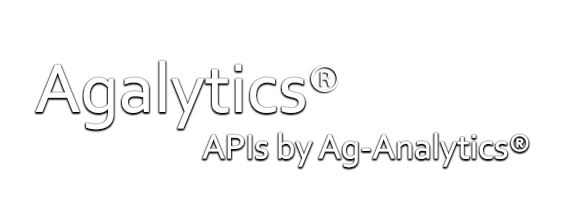TillageAI - BETA
This API is in BETA. Please contact us to demo this API, or for more information on production scale models.
Tillage Identification
The Ag-Analytics® TillageAI API predicts whether or not a provided field has been tilled. The underlying Tillage Model has trained on millions of acres of ground-truth precision data coupled with SAR data, Harmonized Landsat-Sentinel multispectral satellite data, and other data streams. Our models are highly configurable and can incorporate a wide variety of data sources. They are driven by millions of acres-years of precision ag data, which provides unparalleled ground-truth to maximize model efficacy. Please contact us for more information on custom production scale models at support@analytics.ag.

Example of Tillage Identification
Sample API Specifications
Please contact us to demo our tillage models. See sample API call below.GET Request
| Parameter | Description | Example | Request |
|---|---|---|---|
| filename | File name to download. From POST request. Only request a single file at a time. |
result_tillageraster_ 20191126 _175158_3291.tif | https://ag-analytics.azure-api.net/tillage-model/?filename=result_tillageraster_%2020191126%20_175158_3291.tif |
Call API
Request
Request URL
Request parameters
-
File name of the file from POST TillageAI API.
Request body
Code samples
@ECHO OFF
curl -v -X GET "https://ag-analytics.azure-api.net/tillage-model/?filename={filename}"
--data-ascii "{body}"
using System;
using System.Net.Http.Headers;
using System.Text;
using System.Net.Http;
using System.Web;
namespace CSHttpClientSample
{
static class Program
{
static void Main()
{
MakeRequest();
Console.WriteLine("Hit ENTER to exit...");
Console.ReadLine();
}
static async void MakeRequest()
{
var client = new HttpClient();
var queryString = HttpUtility.ParseQueryString(string.Empty);
var uri = "https://ag-analytics.azure-api.net/tillage-model/?filename={filename}&" + queryString;
var response = await client.GetAsync(uri);
}
}
} // // This sample uses the Apache HTTP client from HTTP Components (http://hc.apache.org/httpcomponents-client-ga/)
import java.net.URI;
import org.apache.http.HttpEntity;
import org.apache.http.HttpResponse;
import org.apache.http.client.HttpClient;
import org.apache.http.client.methods.HttpGet;
import org.apache.http.client.utils.URIBuilder;
import org.apache.http.impl.client.HttpClients;
import org.apache.http.util.EntityUtils;
public class JavaSample
{
public static void main(String[] args)
{
HttpClient httpclient = HttpClients.createDefault();
try
{
URIBuilder builder = new URIBuilder("https://ag-analytics.azure-api.net/tillage-model/?filename={filename}");
URI uri = builder.build();
HttpGet request = new HttpGet(uri);
// Request body
StringEntity reqEntity = new StringEntity("{body}");
request.setEntity(reqEntity);
HttpResponse response = httpclient.execute(request);
HttpEntity entity = response.getEntity();
if (entity != null)
{
System.out.println(EntityUtils.toString(entity));
}
}
catch (Exception e)
{
System.out.println(e.getMessage());
}
}
}
<!DOCTYPE html>
<html>
<head>
<title>JSSample</title>
<script src="http://ajax.googleapis.com/ajax/libs/jquery/1.9.0/jquery.min.js"></script>
</head>
<body>
<script type="text/javascript">
$(function() {
var params = {
// Request parameters
};
$.ajax({
url: "https://ag-analytics.azure-api.net/tillage-model/?filename={filename}&" + $.param(params),
beforeSend: function(xhrObj){
// Request headers
},
type: "GET",
// Request body
data: "{body}",
})
.done(function(data) {
alert("success");
})
.fail(function() {
alert("error");
});
});
</script>
</body>
</html>
#import <Foundation/Foundation.h>
int main(int argc, const char * argv[])
{
NSAutoreleasePool * pool = [[NSAutoreleasePool alloc] init];
NSString* path = @"https://ag-analytics.azure-api.net/tillage-model/?filename={filename}";
NSArray* array = @[
// Request parameters
@"entities=true",
];
NSString* string = [array componentsJoinedByString:@"&"];
path = [path stringByAppendingFormat:@"?%@", string];
NSLog(@"%@", path);
NSMutableURLRequest* _request = [NSMutableURLRequest requestWithURL:[NSURL URLWithString:path]];
[_request setHTTPMethod:@"GET"];
// Request headers
// Request body
[_request setHTTPBody:[@"{body}" dataUsingEncoding:NSUTF8StringEncoding]];
NSURLResponse *response = nil;
NSError *error = nil;
NSData* _connectionData = [NSURLConnection sendSynchronousRequest:_request returningResponse:&response error:&error];
if (nil != error)
{
NSLog(@"Error: %@", error);
}
else
{
NSError* error = nil;
NSMutableDictionary* json = nil;
NSString* dataString = [[NSString alloc] initWithData:_connectionData encoding:NSUTF8StringEncoding];
NSLog(@"%@", dataString);
if (nil != _connectionData)
{
json = [NSJSONSerialization JSONObjectWithData:_connectionData options:NSJSONReadingMutableContainers error:&error];
}
if (error || !json)
{
NSLog(@"Could not parse loaded json with error:%@", error);
}
NSLog(@"%@", json);
_connectionData = nil;
}
[pool drain];
return 0;
}
<?php
// This sample uses the Apache HTTP client from HTTP Components (http://hc.apache.org/httpcomponents-client-ga/)
require_once 'HTTP/Request2.php';
$request = new Http_Request2('https://ag-analytics.azure-api.net/tillage-model/?filename={filename}');
$url = $request->getUrl();
$headers = array(
// Request headers
);
$request->setHeader($headers);
$parameters = array(
// Request parameters
);
$url->setQueryVariables($parameters);
$request->setMethod(HTTP_Request2::METHOD_GET);
// Request body
$request->setBody("{body}");
try
{
$response = $request->send();
echo $response->getBody();
}
catch (HttpException $ex)
{
echo $ex;
}
?>########### Python 2.7 #############
import httplib, urllib, base64
headers = {
}
params = urllib.urlencode({
})
try:
conn = httplib.HTTPSConnection('ag-analytics.azure-api.net')
conn.request("GET", "/tillage-model/?filename={filename}&%s" % params, "{body}", headers)
response = conn.getresponse()
data = response.read()
print(data)
conn.close()
except Exception as e:
print("[Errno {0}] {1}".format(e.errno, e.strerror))
####################################
########### Python 3.2 #############
import http.client, urllib.request, urllib.parse, urllib.error, base64
headers = {
}
params = urllib.parse.urlencode({
})
try:
conn = http.client.HTTPSConnection('ag-analytics.azure-api.net')
conn.request("GET", "/tillage-model/?filename={filename}&%s" % params, "{body}", headers)
response = conn.getresponse()
data = response.read()
print(data)
conn.close()
except Exception as e:
print("[Errno {0}] {1}".format(e.errno, e.strerror))
####################################require 'net/http'
uri = URI('https://ag-analytics.azure-api.net/tillage-model/?filename={filename}')
request = Net::HTTP::Get.new(uri.request_uri)
# Request body
request.body = "{body}"
response = Net::HTTP.start(uri.host, uri.port, :use_ssl => uri.scheme == 'https') do |http|
http.request(request)
end
puts response.body
